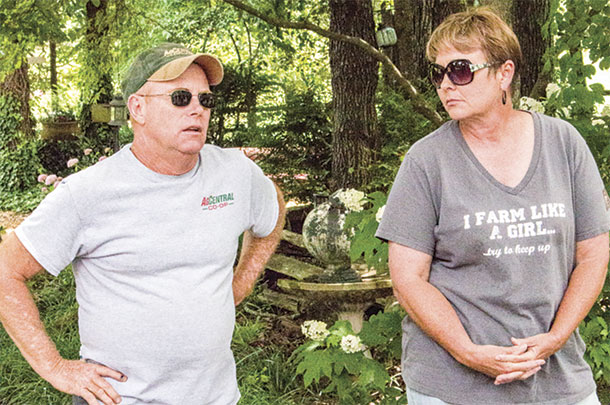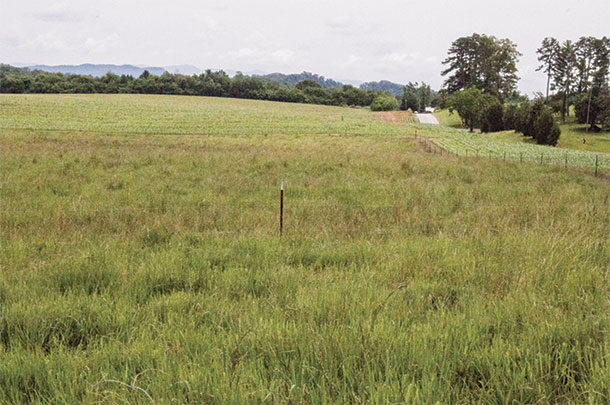The Blacks own and operate Color Wheel Farm, a roughly 1,000-acre beef cattle/row-crop farm near Vonore, Tennessee. Brad handles the row-crop side of the operation, and Kim runs the cattle/grazing side.
She runs 109 cow-calf pairs in an Angus-based breeding program crossed with Hereford, Gelbvieh and Simangus genetics. They graze their cattle on KT-31 fescue, volunteer dallasgrass and, as of the last few years, switchgrass.
The new forage on the block
The Blacks were introduced to switchgrass back in 2008 during the heyday of the bioenergy program, when big companies contracted farmland to grow biomass crops for research and development on producing ethanol and other biofuels.

The Blacks participated in the program until their contract expired, leaving them with several acres of switchgrass and not much to do with it.
Although they put some of their land back into row crops, they still had several acres of switchgrass standing idle and decided to save themselves the expense of plowing and replanting, and Brad Black says, “We decided that since we had that commodity standing there, we’d try to see what we could do by grazing it.”
They didn’t enter the game blind, however. The Blacks sought the advice of forage specialists from the University of Tennessee, with whom they already had a working relationship, and other producers who encouraged them to go forward with the plan. Brad says they started grazing switchgrass around 2013.
Their main inducement to graze switchgrass was the need to use all of their resources. “We had a pretty good stand there, and it was close to a water source and had shade, so we thought we’d try the 30 acres and see what we could do with it,” Brad says.
Grazing was only one of the strategies the Blacks experimented with. They partnered with the University of Tennessee to study the different uses they could put it to.
“We did a research trial with UT on feeding it for haylage,” Black says. “They were trying all kinds of different scenarios, like if we took one cutting of haylage off and then let it mature and took the rest off for biomass, and all sorts of different things.”
The Blacks don’t use grain supplements on switchgrass. They do, however, provide a self-fed supplement that contains an intake modifier to all of their grazing pastures year-round, which is consumed off and on by the cattle.
“They will only eat that product if for some reason the forage is not what they’re needing. It’s the darnedest product we’ve ever dealt with,” Brad says. “When fescue toxicity starts in July and August, our ration intake will go up to about 2.5 pounds per day, but as long as the forage is meeting all the cow’s requirements, she will not eat it.”
Brad says he and Kim keep a close eye on forage levels, especially later in the summer. “We monitor the rate they’re eating it, and if we need to add cows, we will – and if we need to take some away, we can,” he says. “This year we have been blessed with a lot of rain, and we haven’t had to move cows. We had more grass than we knew what to do with.”
Brad says the switchgrass was growing faster than the cows could graze it, so they decided to run a little study of their own. Kim clipped it at three different lengths in three different swaths to see how well it recovered. The lowest she clipped it to was roughly 10 inches tall. “The cattle really liked it where she clipped it a little lower,” Brad says. “They just flock to that area every time they go back. I think it’s just softer and more palatable.”
Results
Before the Blacks had switchgrass pasture, they had a Kentucky-31 fescue-based forage program and grazed volunteer dallasgrass that comes along in the late summer, along with a little orchardgrass they use for hay.
The biggest surprise was higher weaning weights from the cattle grazed on switchgrass. “It was an accidental trial,” Brad says. They grazed a group of their top-performing A.I. cattle on a 100 percent fescue pasture, then weighed them against the other part of their herd grazing on switchgrass.
The calves that had been raised on switchgrass weighed 22 pounds heavier than average. “It was great, and it didn’t cost us any more,” Brad says. “The cattle just grazed it better and milked better,” he says. “It’s pretty eye-opening to see what these calves are doing.” Brad says they are starting to rotate all of their groups on switchgrass.
Make pasture management a priority
Kim has a mantra she uses to run her cattle operation: “I don’t raise cows; I raise grass.” She says this is important from a grazing management side and from an economical side. “If you don’t have grass, you can’t raise cattle,” Brad says. “We’ve learned that if we take care of this grass, we can put pounds on the calves a whole lot cheaper than we could if we used a bunch of supplements.
The longer we can graze that cow without supplementing her with either hay or haylage or any kind of grains, the more money goes in the back pocket at the end of the year.”
The Blacks say that, above all, they are always looking for changes they can make to save money and raise their cattle well, and that it is important to be aware of opportunities, like the switchgrass, that require a change in the system. “It’s just a game,” Brad says. “It’s a learning curve, and we’re still learning with it.” ![]()
PHOTO 1: Kim runs the beef herd and takes care of the switchgrass and other forages while Brad manages the row crop side of the operation.
PHOTO 2: Brad and Kim Black manage two sides of their operation to make the whole farm run smoothly. Photos by Carrie Veselka.

-
Carrie Veselka
- Associate Editor
- Progressive Forage
- Email Carrie Veselka











